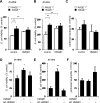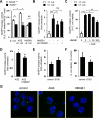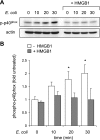Differential activation of RAGE by HMGB1 modulates neutrophil-associated NADPH oxidase activity and bacterial killing
- PMID: 22012330
- PMCID: PMC3328912
- DOI: 10.1152/ajpcell.00302.2011
Differential activation of RAGE by HMGB1 modulates neutrophil-associated NADPH oxidase activity and bacterial killing
Abstract
The receptor for advanced glycation end products (RAGE) plays an important role in host defense against bacterial infection. In the present experiments, we investigated the mechanisms by which RAGE contributes to the ability of neutrophils to eradicate bacteria. Wild-type (RAGE(+/+)) neutrophils demonstrated significantly greater ability to kill Escherichia coli compared with RAGE(-/-) neutrophils. After intraperitoneal injection of E. coli, increased numbers of bacteria were found in the peritoneal fluid from RAGE(-/-) as compared with RAGE(+/+) mice. Exposure of neutrophils to the protypical RAGE ligand AGE resulted in activation of nicotinamide adenine dinucleotide phosphate (NADPH) oxidase and enhanced killing of E. coli, and intraperitoneal injection of AGE enhanced bacterial clearance during peritonitis. However, incubation of neutrophils with high mobility group box 1 protein (HMGB1), which also binds to RAGE, diminished E. coli-induced activation of NADPH oxidase in neutrophils and bacterial killing both in vitro and in vivo. Deletion of the COOH-terminal tail of HMGB1, a region necessary for binding to RAGE, abrogated the ability of HMGB1 to inhibit bacterial killing. Incubation of neutrophils with HMGB1 diminished bacterial or AGE-dependent activation of NADPH oxidase. The increase in phosphorylation of the p40(phox) subunit of NADPH oxidase that occurred after culture of neutrophils with E. coli was inhibited by exposure of the cells to HMGB1. These results showing that HMGB1, through RAGE-dependent mechanisms, diminishes bacterial killing by neutrophils as well as NADPH oxidase activation provide a novel mechanism by which HMGB1 can potentiate sepsis-associated organ dysfunction and mortality.
Figures





References
-
- Angus DC, Yang L, Kong L, Kellum JA, Delude RL, Tracey KJ, Weissfeld L. Circulating high-mobility group box 1 (HMGB1) concentrations are elevated in both uncomplicated pneumonia and pneumonia with severe sepsis. Crit Care Med 35: 1061–1067, 2007 - PubMed
-
- Babior BM. NADPH oxidase: an update. Blood 93: 1464–1476, 1999 - PubMed
-
- Bierhaus A, Schiekofer S, Schwaninger M, Andrassy M, Humpert PM, Chen J, Hong M, Luther T, Henle T, Kloting I, Morcos M, Hofmann M, Tritschler H, Weigle B, Kasper M, Smith M, Perry G, Schmidt AM, Stern DM, Haring HU, Schleicher E, Nawroth PP. Diabetes-associated sustained activation of the transcription factor nuclear factor-kappaB. Diabetes 50: 2792–2808, 2001 - PubMed
Publication types
MeSH terms
Substances
Grants and funding
LinkOut - more resources
Full Text Sources
Molecular Biology Databases

